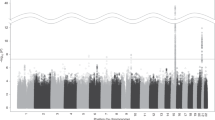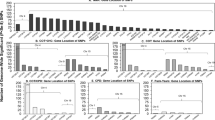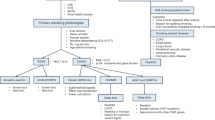Abstract
A single-nucleotide polymorphism (SNP) in the α5 nicotinic acetylcholine receptor subunit gene, rs16969968, has been repeatedly associated with both smoking and respiratory health phenotypes. However, there remains considerable debate as to whether associations with lung cancer are mediated through effects on smoking behavior. Preclinical studies suggest that α5 receptor subunit expression and function may have a direct role in nicotine titration during self administration. The present study investigated the association of CHRNA5 polymorphisms and smoking topography in 66 smokers asked to smoke four nicotine-containing (nicotine yield=0.60 mg) and four placebo (nicotine yield <0.05 mg) cigarettes, during separate experimental sessions. Genotype at rs16969968 predicted nicotine titration, with homozygotes for the major allele (G:G) displaying significantly reduced puff volume in response to nicotine, whereas minor allele carriers (A:G or A:A) produced equivalent puff volumes for placebo and nicotine cigarettes. The present results suggest that puff volume may be a more powerful objective phenotype of smoking behavior than self-reported cigarettes per day and nicotine dependence. Further, these results suggest that the association between rs16969968 and lung cancer may be mediated by the quantity of smoke inhaled.
This is a preview of subscription content, access via your institution
Access options
Subscribe to this journal
Receive 6 print issues and online access
$259.00 per year
only $43.17 per issue
Buy this article
- Purchase on Springer Link
- Instant access to full article PDF
Prices may be subject to local taxes which are calculated during checkout




Similar content being viewed by others
References
The Tobacco and Genetics Consortium.. Genome-wide meta-analyses identify multiple loci associated with smoking behavior. Nat Genet 2010; 42: 441–447.
Bierut LJ . Convergence of genetic findings for nicotine dependence and smoking related diseases with chromosome 15q24–25. Trends Pharmacol Sci 2010; 31: 46–51.
Saccone SF, Hinrichs AL, Saccone NL, Chase GA, Konvicka K, Madden PA et al. Cholinergic nicotinic receptor genes implicated in a nicotine dependence association study targeting 348 candidate genes with 3713 SNPs. Hum Mol Genet 2007; 16: 36–49.
Bierut LJ, Stitzel JA, Wang JC, Hinrichs AL, Grucza RA, Xuei X et al. Variants in nicotinic receptors and risk for nicotine dependence. Am J Psychiatry 2008; 165: 1163–1171.
Kuryatov A, Berrettini W, Lindstrom J . Acetylcholine receptor (AChR) alpha5 subunit variant associated with risk for nicotine dependence and lung cancer reduces (alpha4beta2)alpha5 AChR function. Mol Pharmacol 2011; 79: 119–125.
Johnson EO, Chen LS, Breslau N, Hatsukami D, Robbins T, Saccone NL et al. Peer smoking and the nicotinic receptor genes: an examination of genetic and environmental risks for nicotine dependence. Addiction 2010; 105: 2014–2022.
Sherva R, Wilhelmsen K, Pomerleau CS, Chasse SA, Rice JP, Snedecor SM et al. Association of a single nucleotide polymorphism in neuronal acetylcholine receptor subunit alpha 5 (CHRNA5) with smoking status and with 'pleasurable buzz' during early experimentation with smoking. Addiction 2008; 103: 1544–1552.
Saccone NL, Culverhouse RC, Schwantes-An TH, Cannon DS, Chen X, Cichon S et al. Multiple independent loci at chromosome 15q25.1 affect smoking quantity: a meta-analysis and comparison with lung cancer and COPD. PLoS Genet 2010; 6, pii e1001053.
Chen X, Chen J, Williamson VS, An SS, Hettema JM, Aggen SH et al. Variants in nicotinic acetylcholine receptors alpha5 and alpha3 increase risks to nicotine dependence. Am J Med Genet B Neuropsychiatr Genet 2009; 150B: 926–933.
Hong LE, Yang X, Wonodi I, Hodgkinson CA, Goldman D, Stine OC et al. A CHRNA5 allele related to nicotine addiction and schizophrenia. Genes Brain Behav 2011; 10: 530–535.
Saccone NL, Saccone SF, Hinrichs AL, Stitzel JA, Duan W, Pergadia ML et al. Multiple distinct risk loci for nicotine dependence identified by dense coverage of the complete family of nicotinic receptor subunit (CHRN) genes. Am J Med Genet B Neuropsychiatr Genet 2009; 150B: 453–466.
Xie P, Kranzler HR, Zhang H, Oslin D, Anton RF, Farrer LA et al. Childhood adversity increases risk for nicotine dependence and interacts with alpha5 nicotinic acetylcholine receptor genotype specifically in males. Neuropsychopharmacology 2012; 37: 669–676.
Lips EH, Gaborieau V, McKay JD, Chabrier A, Hung RJ, Boffetta P et al. Association between a 15q25 gene variant, smoking quantity and tobacco-related cancers among 17 000 individuals. Int J Epidemiol 2010; 39: 563–577.
Young RP, Hopkins RJ, Hay BA, Epton MJ, Black PN, Gamble GD . Lung cancer gene associated with COPD: triple whammy or possible confounding effect? Eur Respir J 2008; 32: 1158–1164.
Zienolddiny S, Skaug V, Landvik NE, Ryberg D, Phillips DH, Houlston R et al. The TERT-CLPTM1L lung cancer susceptibility variant associates with higher DNA adduct formation in the lung. Carcinogenesis 2009; 30: 1368–1371.
Yang P, Li Y, Jiang R, Cunningham JM, Zhang F, de Andrade M . A rigorous and comprehensive validation: common genetic variations and lung cancer. Cancer Epidemiol Biomarkers Prev 2010; 19: 240–244.
Sakoda LC, Loomis MM, Doherty JA, Neuhouser ML, Barnett MJ, Thornquist MD et al. Chromosome 15q24–25.1 variants, diet, and lung cancer susceptibility in cigarette smokers. Cancer Causes Control 2011; 22: 449–461.
VanderWeele TJ, Asomaning K, Tchetgen Tchetgen EJ, Han Y, Spitz MR, Shete S et al. Genetic variants on 15q25.1, smoking, and lung cancer: an assessment of mediation and interaction. Am J Epidemiol 2012; 175: 1013–1020.
Munafo MR, Timofeeva MN, Morris RW, Prieto-Merino D, Sattar N, Brennan P et al. Association between genetic variants on chromosome 15q25 locus and objective measures of tobacco exposure.. J Natl Cancer Inst 2012; 104: 740–748.
Benowitz NL, Jacob P, Kozlowski LT, Yu L . Influence of smoking fewer cigarettes on exposure to tar, nicotine, and carbon monoxide. N Engl J Med 1986; 315: 1310–1313.
Benowitz NL, Hall SM, Herning RI, Jacob P, Jones RT, Osman AL . Smokers of low-yield cigarettes do not consume less nicotine. N Engl J Med 1983; 309: 139–142.
Le Marchand L, Derby KS, Murphy SE, Hecht SS, Hatsukami D, Carmella SG et al. Smokers with the CHRNA lung cancer-associated variants are exposed to higher levels of nicotine equivalents and a carcinogenic tobacco-specific nitrosamine. Cancer Res 2008; 68: 9137–9140.
Scherer G . Smoking behaviour and compensation: a review of the literature. Psychopharmacology (Berl) 1999; 145: 1–20.
Fowler CD, Lu Q, Johnson PM, Marks MJ, Kenny PJ . Habenular alpha5 nicotinic receptor subunit signalling controls nicotine intake. Nature 2011; 471: 597–601.
Blank MD, Disharoon S, Eissenberg T . Comparison of methods for measurement of smoking behavior: mouthpiece-based computerized devices versus direct observation. Nicotine Tob Res 2009; 11: 896–903.
Herning RI, Jones RT, Bachman J, Mines AH . Puff volume increases when low-nicotine cigarettes are smoked. Br Med J (Clin Res Ed) 1981; 283: 187–189.
Zacny JP, Stitzer ML, Brown FJ, Yingling JE, Griffiths RR . Human cigarette smoking: effects of puff and inhalation parameters on smoke exposure. J Pharmacol Exp Ther 1987; 240: 554–564.
MacQueen DA, Heckman BW, Blank MD, Janse Van Rensburg K, Evans DE, Drobes DJ . Transient compensatory smoking in response to placebo cigarettes. Psychopharmacology (Berl) 2012; 223: 47–54.
Jackson KJ, Marks MJ, Vann RE, Chen X, Gamage TF, Warner JA et al. Role of alpha5 nicotinic acetylcholine receptors in pharmacological and behavioral effects of nicotine in mice. J Pharmacol Exp Ther 2010; 334: 137–146.
Tuesta LM, Fowler CD, Kenny PJ . Recent advances in understanding nicotinic receptor signaling mechanisms that regulate drug self-administration behavior. Biochem Pharmacol 2011; 82: 984–995.
Amos CI, Wu X, Broderick P, Gorlov IP, Gu J, Eisen T et al. Genome-wide association scan of tag SNPs identifies a susceptibility locus for lung cancer at 15q25.1. Nat Genet 2008; 40: 616–622.
Hansen HM, Xiao Y, Rice T, Bracci PM, Wrensch MR, Sison JD et al. Fine mapping of chromosome 15q25.1 lung cancer susceptibility in African-Americans. Hum Mol Genet 2010; 19: 3652–3661.
Hung RJ, McKay JD, Gaborieau V, Boffetta P, Hashibe M, Zaridze D et al. A susceptibility locus for lung cancer maps to nicotinic acetylcholine receptor subunit genes on 15q25. Nature 2008; 452: 633–637.
King DP, Paciga S, Pickering E, Benowitz NL, Bierut LJ, Conti DV et al. Smoking cessation pharmacogenetics: analysis of varenicline and bupropion in placebo-controlled clinical trials. Neuropsychopharmacology 2012; 37: 641–650.
Stevens VL, Bierut LJ, Talbot JT, Wang JC, Sun J, Hinrichs AL et al. Nicotinic receptor gene variants influence susceptibility to heavy smoking. Cancer Epidemiol Biomarkers Prev 2008; 17: 3517–3525.
Wang JC, Bierut LJ, Goate AM . Variants weakly correlated with CHRNA5 D398N polymorphism should be considered in transcriptional deregulation at the 15q25 locus associated with lung cancer risk. Clin Cancer Res 2009; 15: 5599 author reply 5599.
Wang JC, Grucza R, Cruchaga C, Hinrichs AL, Bertelsen S, Budde JP et al. Genetic variation in the CHRNA5 gene affects mRNA levels and is associated with risk for alcohol dependence. Mol Psychiatry 2009; 14: 501–510.
Weiss RB, Baker TB, Cannon DS, von Niederhausern A, Dunn DM, Matsunami N et al. A candidate gene approach identifies the CHRNA5-A3-B4 region as a risk factor for age-dependent nicotine addiction. PLoS Genet 2008; 4: e1000125.
Winterer G, Mittelstrass K, Giegling I, Lamina C, Fehr C, Brenner H et al. Risk gene variants for nicotine dependence in the CHRNA5-CHRNA3-CHRNB4 cluster are associated with cognitive performance. Am J Med Genet B Neuropsychiatr Genet 2010; 153B: 1448–1458.
Zheng X, Duan W, Xu J, Nie C, Yang Z, Wang H et al. Functionally significant nicotine acetylcholine receptor subunit alpha5 promoter haplotypes are associated with susceptibility to lung cancer in Chinese. Cancer 2011; 117: 4714–4723.
First MB, Spitzer RL, Gibbon M, JBW Williams . Structured Clinical Interview for Axis I DSM-IV Disorders—Patient Edition (SCID-I/P, version 2.0).. Biometrics Research, New York State Psychiatric Institute, 1994.
Heatherton TF, Kozlowski LT, Frecker RC, Fagerstrom KO . The Fagerstrom Test for Nicotine Dependence: a revision of the Fagerstrom Tolerance Questionnaire. Br J Addict 1991; 86: 1119–1127.
Cappelleri JC, Bushmakin AG, Baker CL, Merikle E, Olufade AO, Gilbert DG . Confirmatory factor analyses and reliability of the modified cigarette evaluation questionnaire. Addict Behav 2007; 32: 912–923.
Lee EM, Malson JL, Waters AJ, Moolchan ET, Pickworth WB . Smoking topography: reliability and validity in dependent smokers. Nicotine Tob Res 2003; 5: 673–679.
Ahijevych K, Gillespie J . Nicotine dependence and smoking topography among black and white women. Res Nurs Health 1997; 20: 505–514.
Ahijevych K, Gillespie J, Demirci M, Jagadeesh J . Menthol and nonmenthol cigarettes and smoke exposure in black and white women. Pharmacol Biochem Behav 1996; 53: 355–360.
Veilleux JC, Kassel JD, Heinz AJ, Braun A, Wardle MC, Greenstein J et al. Predictors and sequelae of smoking topography over the course of a single cigarette in adolescent light smokers. J Adolesc Health 2011; 48: 176–181.
Collins CC, Epstein DH, Parzynski CS, Zimmerman D, Moolchan ET, Heishman SJ . Puffing behavior during the smoking of a single cigarette in tobacco-dependent adolescents. Nicotine Tob Res 2010; 12: 164–167.
Wood T, Wewers ME, Groner J, Ahijevych K . Smoke constituent exposure and smoking topography of adolescent daily cigarette smokers. Nicotine Tob Res 2004; 6: 853–862.
Franken FH, Pickworth WB, Epstein DH, Moolchan ET . Smoking rates and topography predict adolescent smoking cessation following treatment with nicotine replacement therapy. Cancer Epidemiol Biomarkers Prev 2006; 15: 154–157.
Strasser AA, Pickworth WB, Patterson F, Lerman C . Smoking topography predicts abstinence following treatment with nicotine replacement therapy. Cancer Epidemiol Biomarkers Prev 2004; 13 (11 Part 1): 1800–1804.
Hong LE, Hodgkinson CA, Yang Y, Sampath H, Ross TJ, Buchholz B et al. A genetically modulated, intrinsic cingulate circuit supports human nicotine addiction. Proc Natl Acad Sci USA 2010; 107: 13509–13514.
Bailey CD, De Biasi M, Fletcher PJ, Lambe EK . The nicotinic acetylcholine receptor alpha5 subunit plays a key role in attention circuitry and accuracy. J Neurosci 2010; 30: 9241–9252.
Heishman SJ, Kleykamp BA, Singleton EG . Meta-analysis of the acute effects of nicotine and smoking on human performance. Psychopharmacology (Berl) 2010; 210: 453–469.
Balaban MT, Losito BDG, Simons RF, Graham FK . Off-line latency and amplitude scoring of the human reflex blink with Fortran IV. Psychophysiology 1986; 23: 612.
Ware JJ, van den Bree M, Munafo MR . From Men to Mice: CHRNA5/CHRNA3, Smoking Behavior and Disease.. Nicotine Tob Res 2012; 14: 1291–1299.
Acknowledgements
This study was funded by NIH grants R21 DA027001, R21 DA024226 and R25 CA090314. The authors would like to thank Renee Ornduff and Natasha Garcia for their work on the project.
Author information
Authors and Affiliations
Corresponding author
Ethics declarations
Competing interests
The authors declare no conflict of interest.
Rights and permissions
About this article
Cite this article
MacQueen, D., Heckman, B., Blank, M. et al. Variation in the α 5 nicotinic acetylcholine receptor subunit gene predicts cigarette smoking intensity as a function of nicotine content. Pharmacogenomics J 14, 70–76 (2014). https://doi.org/10.1038/tpj.2012.50
Received:
Revised:
Accepted:
Published:
Issue Date:
DOI: https://doi.org/10.1038/tpj.2012.50
Keywords
This article is cited by
-
Nicotinic acetylcholine gene cluster CHRNA5-A3-B4 variants influence smoking status in a Bangladeshi population
Pharmacological Reports (2021)
-
Earlier smoking after waking and the risk of asthma: a cross-sectional study using NHANES data
BMC Pulmonary Medicine (2018)
-
Neurobiological Considerations for Tobacco Use Disorder
Current Behavioral Neuroscience Reports (2018)
-
Pharmacogenetic study of seven polymorphisms in three nicotinic acetylcholine receptor subunits in smoking-cessation therapies
Scientific Reports (2017)



